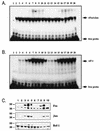Cysteine 64 of Ref-1 is not essential for redox regulation of AP-1 DNA binding
- PMID: 12773568
- PMCID: PMC156143
- DOI: 10.1128/MCB.23.12.4257-4266.2003
Cysteine 64 of Ref-1 is not essential for redox regulation of AP-1 DNA binding
Abstract
Ref-1 participates in DNA repair as well as in redox regulation of transcription factor function. The redox function of Ref-1 involves reduction of oxidized cysteine residues within the DNA binding domains of several transcription factors, including Fos and Jun. Reduction of these residues is required for DNA binding, providing a redox-dependent mechanism for regulation of target gene expression. Previous in vitro studies implicated cysteine 65 of human Ref-1 (cysteine 64 of mouse Ref-1) as the redox catalytic site. We analyzed the in vivo role of cysteine 64 in redox regulation of AP-1 activity by introducing a cysteine-to-alanine point mutation into the endogenous mouse Ref-1 gene (ref-1(C64A)). Unlike Ref-1 null mice, which die very early in embryonic development, homozygous ref-1(C64A) mice are viable, they survive to normal life expectancy, and they display no overt abnormal phenotype. Although Ref-1 provides the major AP-1-reducing activity in murine cells, ref-1(C64A) cells retain normal levels of endogenous AP-1 DNA binding activity in vivo as well as normal Fos- and Jun-reducing activity in vitro. These results demonstrate that Ref-1 cysteine 64/65 is not required for redox regulation of AP-1 DNA binding in vivo, and they challenge previous hypotheses regarding the mechanism by which Ref-1 regulates the redox-dependent activity of specific transcription factors.
Figures






Similar articles
-
Redox factor-1 (Ref-1) mediates the activation of AP-1 in HeLa and NIH 3T3 cells in response to heat shock.J Biol Chem. 1999 Jun 11;274(24):16959-64. doi: 10.1074/jbc.274.24.16959. J Biol Chem. 1999. PMID: 10358044
-
Redox regulation of the DNA repair function of the human AP endonuclease Ape1/ref-1.Antioxid Redox Signal. 2001 Aug;3(4):671-83. doi: 10.1089/15230860152543014. Antioxid Redox Signal. 2001. PMID: 11554453
-
Phosphorylation of the DNA repair protein APE/REF-1 by CKII affects redox regulation of AP-1.Oncogene. 1999 Jan 28;18(4):1033-40. doi: 10.1038/sj.onc.1202394. Oncogene. 1999. PMID: 10023679
-
Going APE over ref-1.Mutat Res. 2000 Oct 16;461(2):83-108. doi: 10.1016/s0921-8777(00)00046-x. Mutat Res. 2000. PMID: 11018583 Review.
-
Inhibitors of nuclease and redox activity of apurinic/apyrimidinic endonuclease 1/redox effector factor 1 (APE1/Ref-1).Bioorg Med Chem. 2017 May 1;25(9):2531-2544. doi: 10.1016/j.bmc.2017.01.028. Epub 2017 Jan 21. Bioorg Med Chem. 2017. PMID: 28161249 Review.
Cited by
-
Human apurinic/apyrimidinic endonuclease 1.Antioxid Redox Signal. 2014 Feb 1;20(4):678-707. doi: 10.1089/ars.2013.5492. Epub 2013 Aug 20. Antioxid Redox Signal. 2014. PMID: 23834463 Free PMC article. Review.
-
Secreted APE1/Ref-1 inhibits TNF-α-stimulated endothelial inflammation via thiol-disulfide exchange in TNF receptor.Sci Rep. 2016 Mar 11;6:23015. doi: 10.1038/srep23015. Sci Rep. 2016. PMID: 26964514 Free PMC article.
-
Redox-based regulation of signal transduction: principles, pitfalls, and promises.Free Radic Biol Med. 2008 Jul 1;45(1):1-17. doi: 10.1016/j.freeradbiomed.2008.03.011. Epub 2008 Mar 27. Free Radic Biol Med. 2008. PMID: 18423411 Free PMC article. Review.
-
Redox homeostasis: the linchpin in stem cell self-renewal and differentiation.Cell Death Dis. 2013 Mar 14;4(3):e537. doi: 10.1038/cddis.2013.50. Cell Death Dis. 2013. PMID: 23492768 Free PMC article. Review.
-
Knockout and Inhibition of Ape1: Roles of Ape1 in Base Excision DNA Repair and Modulation of Gene Expression.Antioxidants (Basel). 2022 Sep 15;11(9):1817. doi: 10.3390/antiox11091817. Antioxidants (Basel). 2022. PMID: 36139891 Free PMC article.
References
-
- Abate, C., L. Patel, F. J. Rauscher III, and T. Curran. 1990. Redox regulation of fos and jun DNA-binding activity in vitro. Science 249:1157-1161. - PubMed
-
- Beiqing, L., M. Chen, and R. L. Whisler. 1996. Sublethal levels of oxidative stress stimulate transcriptional activation of c-jun and suppress IL-2 promoter activation in Jurkat T cells. J. Immunol. 157:160-169. - PubMed
Publication types
MeSH terms
Substances
Grants and funding
LinkOut - more resources
Full Text Sources
Molecular Biology Databases
Research Materials
Miscellaneous
